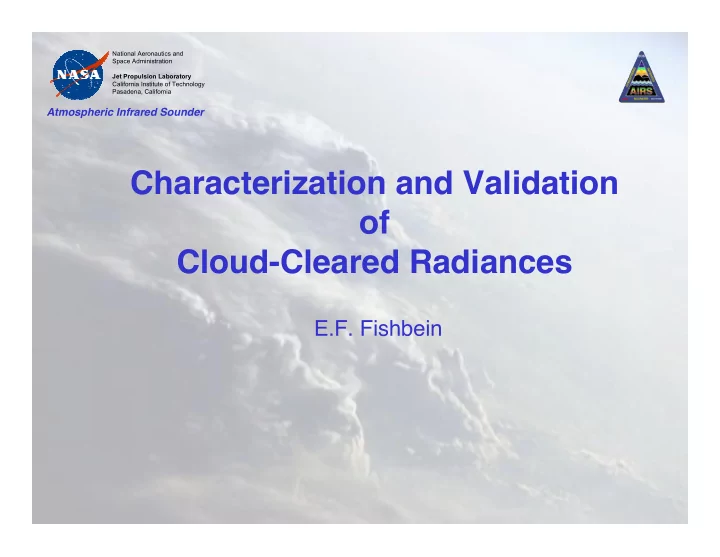

National Aeronautics and Space Administration Jet Propulsion Laboratory California Institute of Technology Pasadena, California Atmospheric Infrared Sounder Characterization and Validation of Cloud-Cleared Radiances E.F. Fishbein
National Aeronautics and Space Administration Outline Jet Propulsion Laboratory California Institute of Technology Pasadena, California Atmospheric Infrared Sounder • ECMF – AIRS inter-comparisons – Dependence on cloud discriminants – SST outlier rates (2K threshold) • Radiance Covariance – Clear – versus cloud-cleared • Inter-comparison of versions 4.0 and 3.5 Time of Default Name Name Description Location Day Condition Difference of SST from LW and SW channels, SST1231r5- > -2K d2392r1 d2392r1 SST2392r1 Ocean Day/Night LW Thin cirrus and silicate dust d23 d23 abs < 0.25K predictor Ocean Day/Night 2
Version 3.5 National Aeronautics and Space Administration Jet Propulsion Laboratory SST Inter-comparisons California Institute of Technology Pasadena, California Atmospheric Infrared Sounder Outlier Rate LW Thin Cirrus Test 1231 / 943 cm - 1 • Discriminant smaller than clear threshold (density of discriminant) • Density of SST differences are independent of discriminant • Precision (bias) and accuracy of SST independent of discriminant Cloud-clearing is working to reliability of discriminant and/or Correlative SST 3
National Aeronautics and Version 3.5 Space Administration Jet Propulsion Laboratory California Institute of Technology Clear versus Cloud-Cleared Covariance Pasadena, California Atmospheric Infrared Sounder 4
National Aeronautics and Space Administration Version 3.5 Conclusions Jet Propulsion Laboratory California Institute of Technology Pasadena, California Atmospheric Infrared Sounder • Application of cloud-contamination test – Most of CC radiances past test • Assessment of quality based on impact on retrieved products – Outlier rate not dependent on clear test • Suggests outliers do not arise from errors in CC radiances • Statistical Characteristics – Small differences in most significant eigenvectors • Larger more varied ensemble of states • Cloud clearing has only 6 degrees of freedom per AMSU footprint – Correlated errors in cloud formations could amplify variance – AMSU systematic errors could produce correlated errors in cloud formations – Larger eigenvalues at least significant eigenvalues • Evidence for noise amplification 5
Version 4.0 National Aeronautics and Space Administration Jet Propulsion Laboratory SST Inter-comparisons California Institute of Technology Pasadena, California Atmospheric Infrared Sounder Outlier Rate • Possibly more skill • Outlier rate decreasing with tightening 6
Version 4.0 National Aeronautics and Space Administration Jet Propulsion Laboratory SST Inter-comparisons California Institute of Technology Pasadena, California Atmospheric Infrared Sounder Outlier Rate LW / SW SST Difference • Same as Version 3.4 • Discriminant smaller than clear threshold • Density of SST differences independent of discr. • Precision (bias) and accuracy of SST are independent of discr. – Decreases with discr – Outlier rate increases • Cloud-clearing is working to reliability of discriminant 7
National Aeronautics and Version 4.0 Space Administration Jet Propulsion Laboratory California Institute of Technology Clear versus Cloud-Cleared Eigenvalues Pasadena, California Atmospheric Infrared Sounder 8
National Aeronautics and Version 4.0 Space Administration Jet Propulsion Laboratory California Institute of Technology Clear versus Cloud-Cleared Covariance Pasadena, California Atmospheric Infrared Sounder 9
National Aeronautics and Space Administration Noise Amplification Jet Propulsion Laboratory California Institute of Technology Pasadena, California Atmospheric Infrared Sounder • Increase in radiance noise by cloud clearing • Applicable to surface sensing channels • 9 clear footprints has NaF of 1/3 • Concern about amplification of systematic errors 10
Covariance Dependence on National Aeronautics and Space Administration Jet Propulsion Laboratory California Institute of Technology Noise Amplification Pasadena, California Atmospheric Infrared Sounder 11
Weighting Function Through National Aeronautics and Space Administration Jet Propulsion Laboratory California Institute of Technology Cloud Layers Pasadena, California Atmospheric Infrared Sounder 12
Height –Dependence of Noise National Aeronautics and Space Administration Jet Propulsion Laboratory California Institute of Technology Amplification Pasadena, California Atmospheric Infrared Sounder 13
National Aeronautics and Space Administration Latitude Sampling Jet Propulsion Laboratory California Institute of Technology Pasadena, California Atmospheric Infrared Sounder 14
National Aeronautics and Space Administration Conclusions Jet Propulsion Laboratory California Institute of Technology Pasadena, California Atmospheric Infrared Sounder • Application of cloud-contamination test – Most of CC radiances past test • Assessment of quality based on impact on retrieved products – Outlier rate not dependent on clear test • Suggests outliers do not arise from errors in CC radiances • Statistical Characteristics – Small differences in most significant eigenvectors • Larger more varied sample of states – Larger eigenvalues at least significant • Evidence of noise amplification 15
805 cm -1 Bias (Window Channel with Strong Water Continuum) CC = cloud cleared UC = uniform clear
National Aeronautics and Space Administration Clear Scene Prescription Jet Propulsion Laboratory California Institute of Technology Pasadena, California Atmospheric Infrared Sounder Time of Default Description Day Condition Name Name Location SST from LW channels using a SST1231r5 SST1231r5 split window Ocean Day/Night SST from SW channels using SST2392r1 SST2392r1 lapse rate extrapolation Ocen Day/Night Difference of SST from LW and SW channels, SST1231r5- d2392r1 d2392r1 SST2392r1 Ocean Day/Night > -2K SST LW/SW difference with glint dd12g5 dd12g5 correction Ocean Day abs < 0.5K SST LW/SW difference w/o glint d12 d12 correction Ocean Night abs < 0.25K LW Thin cirrus and silicate dust d23 d23 predictor Ocean Day/Night abs < 0.25K d34 d34 LW Thin cirrus predictor Ocean Day/Night abs < 0.5K lrt lrt SW lapse rate Tropical Ocean Day/Night > 3.5K g5n g5n SW sun glint detector Ocean Day < 3 spatial_coh spatial_coh Std Deviation in LW predicted 11 11 um um SST Everywhere Day/Night < 0.5 17
National Aeronautics and Space Administration Jet Propulsion Laboratory California Institute of Technology Pasadena, California Atmospheric Infrared Sounder Supplemental Slides
Empirical Orthogonal Functions National Aeronautics and Space Administration Jet Propulsion Laboratory California Institute of Technology Data Pasadena, California Atmospheric Infrared Sounder • Train on 826,340 identified clear spectra ( 11 Focus Days ) • LW temperature sounding channels (470) 19
Recommend
More recommend